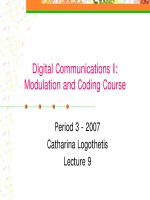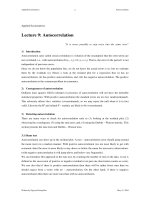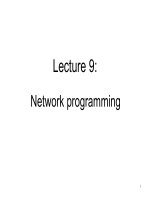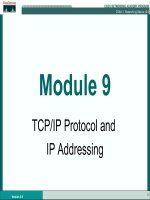MRI basics lecture 9 26
Bạn đang xem bản rút gọn của tài liệu. Xem và tải ngay bản đầy đủ của tài liệu tại đây (1.12 MB, 35 trang )
Magnetic Resonance Imaging:
Physical Principles
Lewis Center for
NeuroImaging
,
Physics of MRI, An Overview
Nuclear Magnetic Resonance
– Nuclear spins
– Spin precession and the
Larmor equation
– Static B0
– RF excitation
– RF detection
Spatial Encoding
– Slice selective excitation
– Frequency encoding
– Phase encoding
– Image reconstruction
08/13/20
Fourier Transforms
– Continuous Fourier
Transform
– Discrete Fourier Transform
– Fourier properties
– k-space representation in
MRI
2
Physics of MRI
Echo formation
– Vector summation
– Phase dispersion
– Phase refocus
2D Pulse Sequences
– Spin echo
– Gradient echo
– Echo-Planar Imaging
08/13/20
Medical Applications
– Contrast in MRI
– Bloch equation
Tissue properties
– T1 weighted imaging
– T2 weighted imaging
– Spin density imaging
Examples
3D Imaging
Spectroscopy
3
Many spins in a voxel: vector summation
spins in step
spins not in step
Rotating
frame
Lamor
precession
08/13/20
4
Phase dispersion due to perturbing B
fields
Spin Phase φ ∝ γ Bt
B = B0 + δB0 + δBcs + δBpp
sampling
Immediately after RF excitation
08/13/20
sometime after RF excitation
5
Refocus spin phase – echo formation
Echo Time (TE)
• Invert perturbing field:
δB
Phase
0
δBt
(gradient echo, k-space sampling)
• Invert spin state:
Phase
0
(spin echo)
08/13/20
δBt
-δB
φ-δB(t-TE/2)
φ -φ
-φ+δB(t-TE/2)
time
0
0
6
Spin Echo
Spins dephase with time
Rephase spins with a 180° pulse
Echo time, TE
Repeat time, TR
(Running analogy)
1 . E q u ilib riu m
2 . 9 0 P u lse
t= 0
3 . S p in D e p h a s in g
5 . S p in e c h o
t= T E
08/13/20
4 . 1 8 0 P u lse
t= T E /2
7
Frequency encoding - 1D imaging
Spatial-varying resonance frequency during RF detection
B = B0 + Gxx
S(t) ~ eiγ Βt
S(t) ~ ∫ m(x)eiγ Gxxtdx
m(x)
x
S(t) = ∫ m(x)eikxxdx = S(kx),
08/13/20
kx = γ Gxt
m(x) = FT{S(kx)}
8
Slice selection
Spatial-varying resonance frequency during RF excitation
ω
ω = ω0 + γ Gzz
B1 freq band
z
Excited location
Slice profile
m+ = mx+imy ~ γ ∫ b1(t)e-iγ Gzztdt = B1(γ Gzz)
08/13/20
9
Gradient Echo FT imaging
35000
Amplitude (arb)
x Gradient
ky
0
-35000
Amplitude (arb)
35000
Readout
y Gradient
0
-35000
Amplitude (arb)
35000
kx
z Gradient
0
γ
k (t ) =
G (t )dt
∫
2π
-35000
Amplitude (arb)
35000
RF
0
-35000
0
2000
4000
Time (us)
6000
08/13/20
8000
10000
Repeat with different phase-encoding
amplitudes to fill k-space
10
Pulse sequence design
35000
prewinder
spoiler
Amplitude (arb)
x Gradient
0
rephasor
Amplitude (arb)
35000
-35000
y Gradient
0
Amplitude (arb)
rewinder
spoiler
Amplitude (arb)
35000
-35000
z Gradient
0
35000
-35000
RF
0
-35000
08/13/20
0
2000
4000
Time (us)
6000
8000
10000
11
X
EPI (echo planar imaging)
ky
Y
Z
kx
RF
time
Quick, but very susceptible to artifacts, particularly B 0 field inhomogeneity.
Can acquire a whole image with one RF pulse – single shot EPI
08/13/20
12
Spin Echo FT imaging
Amplitude (arb)
35000
ky
x Gradient
0
-35000
Amplitude (arb)
35000
Readout
y Gradient
0
-35000
Amplitude (arb)
35000
z Gradient
γ
k (t ) =
G (t )dt
∫
2π
0
-35000
Amplitude (arb)
35000
kx
RF
0
-35000
0
5000
10000 Time (us) 15000
08/13/20
20000
25000
Repeat with different phase-encoding
amplitudes to fill k-space
13
Spin Relaxation
Spins do not continue to precess forever
Longitudinal magnetization returns to equilibrium due to spin-lattice interactions – T1 decay
Transverse magnetization is reduced due to both spin-lattice energy loss and local, random, spin
dephasing – T2 decay
Additional dephasing is introduced by magnetic field inhomogeneities within a voxel – T2' decay.
This can be reversible, unlike T2 decay
08/13/20
14
Bloch Equation
The equation of MR physics
1
dM
1
= γM × B + ( M 0 − M z ) zˆ + M ⊥
dt
T1
T2
Summarizes the interaction of a nuclear spin with the external
magnetic field B and its local environment (relaxation effects)
08/13/20
15
Contrast - T1 Decay
Longitudinal relaxation due to spin-lattice
interaction
1.0
Mz grows back towards its equilibrium
o
180 Pulse
value, M0
Mz/M0
0.5
− t / T1
MForzshort
(t )TR,=equilibrium
M 0 (1moment
− e is reduced)
0.0
Inversion Recovery
-0.5
-1.0
0
1
2
3
4
5
t/T1
08/13/20
16
Contrast - T2 Decay
Transverse relaxation due to spin dephasing
T2 irreversible dephasing
T2/ reversible dephasing
Combined effect
08/13/20
0.8
Mx(t)/Mx(0)
1
1 1
= + /
*
T2 T2 T2
M ⊥ (t ) = M ⊥ (0)e
1.0
0.6
0.4
0.2
0.0
−t / T2*
0
1
2
*
t/T2
3
4
17
5
Free Induction Decay –
Gradient echo (GRE)
Excite spins, then measure decay
Problems:
MR signal
– Rapid signal decay
– Acquisition must be
e-t/T2*
disabled during RF
– Don’t get central
“echo” data
time
0
90 RF
08/13/20
18
Spin echo (SE)
MR signal
e-t/T2
e-t/T2*
time
0
90 RF
08/13/20
0
180 RF
19
MR Parameters: TE and TR
Echo time, TE is the time from the RF excitation to the center of the echo being received.
Shorter
echo times allow less T2 signal decay
Repetition time, TR is the time between one acquisition and the next.
Short TR values do not
allow the spins to recover their longitudinal magnetization, so the net magnetization available is
reduced, depending on the value of T1
Short TE and long TR give strong signals
08/13/20
20
Contrast, Imaging Parameters
S(TR , TE ) ∝ ρ(1 − e
or ρ(1 − e
− TR / T1
− TR / T1
)e
)e
− TE / T2
− TE / T2*
(SE )
(GRE)
TE
TR Image Weighting
Short Long
Proton
Short Short
T1
*
Long Long
T2, T2
08/13/20
21
Properties of Body Tissues
Tissue
T1 (ms) T2 (ms)
Grey Matter (GM)
950
100
White Matter (WM)
600
80
Muscle
900
50
Cerebrospinal Fluid (CSF)
4500
2200
Fat
250
60
Blood
1200
100-200
MRI has high contrast for different tissue types!
08/13/20
22
MRI of the Brain - Sagittal
T1 Contrast
TE = 14 ms
TR = 400 ms
08/13/20
T2 Contrast
TE = 100 ms
TR = 1500 ms
Proton Density
TE = 14 ms
TR = 1500 ms
23
MRI of the Brain - Axial
T1 Contrast
TE = 14 ms
TR = 400 ms
08/13/20
T2 Contrast
TE = 100 ms
TR = 1500 ms
Proton Density
TE = 14 ms
TR = 1500 ms
24
Brain - Sagittal Multislice T1
08/13/20
25









